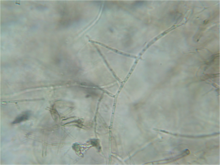Thanatephorus cucumeris
| Rhizoctonia solani (Anamorph) | |
|---|---|
 |
|
| R. solani hyphae showing the distinguishing right angles | |
| Scientific classification | |
| Kingdom: | Fungi |
| Division: | Basidiomycota |
| Class: | Agaricomycetes |
| Order: | Cantharellales |
| Family: | Ceratobasidiaceae |
| Genus: | Rhizoctonia |
| Species: | R. solani |
| Binomial name | |
|
Rhizoctonia solani J.G. Kühn 1858 |
|
| Synonyms | |
|
Moniliopsis aderholdii Ruhland 1908 |
|
| Thanatephorus cucumeris (teleomorph) | |
|---|---|
| Scientific classification | |
| Kingdom: | Fungi |
| Division: | Basidiomycota |
| Class: | Agaricomycetes |
| Order: | Cantharellales |
| Family: | Ceratobasidiaceae |
| Genus: | Thanatephorus |
| Species: | T. cucumeris |
| Binomial name | |
|
Thanatephorus cucumeris (A.B. Frank) Donk 1956 |
|
| Synonyms | |
|
Corticium sasakii (Shirai) H. Matsumoto 1934 |
|
Moniliopsis aderholdii Ruhland 1908
Moniliopsis solani (J.G. Kühn) R.T. Moore 1987
Rhizoctonia grisea (J.A. Stev.) Matz 1920
Rhizoctonia napaeae Westend. & Wallays 1846
Rhizoctonia solani (teleomorph: Thanatephorus cucumeris) is a plant pathogenic fungus with a wide host range and worldwide distribution. It was discovered more than 100 years ago. R. solani frequently exists as thread-like growth on plants or in culture, and is considered a soil-borne pathogen. R. solani is best known to cause various plant diseases such as collar rot, root rot, damping off, and wire stem. R. solani attacks its hosts when they are in their early stages of development, such as seeds and seedlings, which are typically found in the soil. The pathogen is known to cause serious plant losses by attacking primarily the roots and lower stems of plants. Although it has a wide range of hosts, its main targets are herbaceous plants. R. solani would be considered a basidiomycete fungus if the teleomorph stage were more abundant. The pathogen is not currently known to produce any asexual spores (conidia), though it is considered to have an asexual lifecycle. Occasionally, sexual spores (basidiospores) are produced on infected plants. The disease cycle of R. solani is important in management and control of the pathogen.
In 1858, Julius Kuhn observed and described a fungus on diseased potato tubers and named it Rhizoctonia solani. Rhizooctonia is from Ancient Greek, ῥίζα (rhiza, "root") + κτόνος (ktonos, "murder"). Solanum, Latin for nightshade, is the genus of the potato. The disease caused was well-known before the discovery and description of the fungus.
R. solani causes a wide range of commercially significant plant diseases. It is one of the fungi responsible for brown patch (a turfgrass disease), damping off (e.g. in soybean seedlings), black scurf of potatoes, bare patch of cereals,root rot of sugar beet, belly rot of cucumber, sheath blight of rice, and many other pathogenic conditions. The fungus, therefore, has a wide host range and strains of R. solani may differ in the hosts they are able to infect, the virulence of infection, selectivity for a given host ranges from nonpathogenic to highly virulent, the temperature at which infection occurs, the ability to develop in lower soil levels, the ability to form sclerotia, the growth rate, and survival in a certain area. These factors may not always show up given the environment and host that Rhizoctonia attacks.
...
Wikipedia
